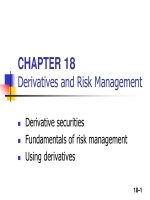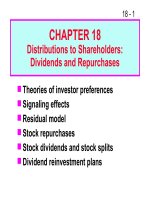Management ch 18 teamwork
Bạn đang xem bản rút gọn của tài liệu. Xem và tải ngay bản đầy đủ của tài liệu tại đây (405.8 KB, 30 trang )
Chapter 18
Teamwork
Teamwork
Over the past two decades, the use of teams has increased
dramatically in response to
new
the
competitive pressures,
need for greater flexibility and speed, &
a
desire to give people more opportunities for
involvement
Manager’s Challenge: Rowe
2
Copyright © 2005 by South-Western, a division of Thomson Learning. All rights reserved.
Teamwork
3
Topics
Chapter 18
Teams & their applications within organizations
Types of teams
Stages of Development
Team Characteristics
Individual contributions to teams
Teamwork costs and benefits
Ability to manage teams – component of
manager and organization success
Copyright © 2005 by South-Western, a division of Thomson Learning. All rights reserved.
What is a Team?
4
Unit of 2 or more people
Interact or coordinate their work
To accomplish a specific goal
Copyright © 2005 by South-Western, a division of Thomson Learning. All rights reserved.
Differences Between
Groups and Teams
Groups
5
Teams
Designated leader
Individual accountability
Identical purpose for group
& organization
Individual work products
Runs efficient meetings
Effectiveness=influence on
business
Discusses, decides,
delegates work to
individuals
Shares/rotates leader
Accountable to each other
Specific team vision or
purpose
Collective work products
Encourages open-ended
discussions
Effectiveness=value of
collective work
Discusses, decides, shares
work
Copyright © 2005 by South-Western, a division of Thomson Learning. All rights reserved.
Work Team Effectiveness Model
6
Copyright © 2005 by South-Western, a division of Thomson Learning. All rights reserved.
Formal Teams
Vertical - composed of a manager and subordinates,
sometimes called functional or command teams.
Horizontal - composed of employees from the same
hierarchical level but from different areas of expertise.
Special-Purpose - created outside the formal
organization for special projects and disband once
project is completed.
7
Copyright © 2005 by South-Western, a division of Thomson Learning. All rights reserved.
Self-Directed Team Elements
Typically permanent teams
8
Employees with several skills and functions
Given access to various resources – information, equipment,
machinery, and supplies needed to perform the complete task
Empowered with decision making authority select new
members - $
Copyright © 2005 by South-Western, a division of Thomson Learning. All rights reserved.
Teams in the New Workplace
9
Virtual teams- consist of geographically or
organizationally dispersed members linked via
technology
Global teams- cross-border teams made up of
members from different nationalities
–
intercultural
–
virtual
Copyright © 2005 by South-Western, a division of Thomson Learning. All rights reserved.
Challenges of Virtual Teams
10
Select the right team members
Manage socialization
Foster trust
Effectively manage communications
Copyright © 2005 by South-Western, a division of Thomson Learning. All rights reserved.
Characteristics of Teams
Teams of 5-12 seem to work best
11
Size--
Ideal size is thought to be 7
Variations of from 5 to 12 typically are associated
with good team performance
Small teams (2-4 members) show more agreement,
ask more questions
Large teams (12 or more) tend to have more
disagreements; subgroups form, conficts among
them occur
Copyright © 2005 by South-Western, a division of Thomson Learning. All rights reserved.
Characteristics of Teams
Size
12
- Diversity -
Member Roles
Diversity
Produce more innovative solutions to problems
Source of creativity
Contribute to a healthy level of conflict that leads to
decision making
Work team performance –racial, national, ethnic
Short term = difficulty learning to work together
Leadership helps problems fade over time
Copyright © 2005 by South-Western, a division of Thomson Learning. All rights reserved.
Characteristics of Teams
spend time and energy helping the team reach its goal
13
Member Roles-
Task specialist role spend
time and energy helping the
team reach its goal
Initiate ideas
Give opinions
Seek information
Summarize
Energize
Copyright © 2005 by South-Western, a division of Thomson Learning. All rights reserved.
Socio-emotional role
support team members’
emotional needs
Encourage
Harmonize
Reduce
tension
Follow
Compromise
Team Member Roles
High
Task Specialist Role
· Focuses on task
accomplishment
over human needs.
· Important role, but if adopted
by everyone, team’s social
Member needs won’t be met.
Task
Behavior Nonparticipator Role
· Contributes little to either task
or
people needs of team.
· Not an important role-if adopted
by too many members, team
will disband.
Low
Low
14
Dual Role
· Focuses on task and people.
· May be a team leader.
· Important role, but not
essential if members adopt
task specialist and
socioemotional roles.
Socioemotional Role
· Focuses on people needs of
team over task.
· Important role, but if adopted
by everyone, team’s tasks
won’t be accomplished.
Member Social Behavior
Copyright © 2005 by South-Western, a division of Thomson Learning. All rights reserved.
High
Stages of Team Development
Adjourning:
Task completion
Leader: Bring closure, signify completion
Performing:
Cooperation, problem solving
Leader: Facilitate task
accomplishment
Norming:
Establishment of order and cohesion
Leader: Help clarify team roles, norms, values
Storming:
Conflict, disagreement
Leader: Encourage participation
Forming:
Orientation, break the ice
Leader: Facilitate social interchanges
15
Copyright © 2005 by South-Western, a division of Thomson Learning. All rights reserved.
Team Cohesiveness
High cohesiveness is attractive feature of team
16
Extent to which team members are
attracted to the team and motivated
to remain in it
Determinants
Team structure
Context
Copyright © 2005 by South-Western, a division of Thomson Learning. All rights reserved.
Determinants of Team Cohesiveness
Team structure and context influence cohesiveness
Team
17
Structure
Team interaction - the more time spent together, the more
cohesive the team
Shared goals - members agree on goals, they will be more
cohesive
Personal attraction to the team - similar attitudes and
values and enjoy being together
Copyright © 2005 by South-Western, a division of Thomson Learning. All rights reserved.
Determinants of Team Cohesiveness
Team structure and context influence cohesiveness
Team
18
Context
Moderate competition with other teams – cohesiveness
increases as it strives to win
Team success & favorable evaluation of the team by
outsiders – add to cohesiveness
Copyright © 2005 by South-Western, a division of Thomson Learning. All rights reserved.
Consequences of Team Cohesiveness
High morale – mixed team performance
Morale – higher in cohesive teams
–
Increased communication among members
Friendly team climate
–
Maintenance of membership
–
Team Performance – mixed
–
–
Cohesive Team members’ productivity tends to be uniform
Non-cohesive teams have wider variation in member
productivity
Experiential Exercise: Is Your Group a Cohesive Team?
19
Copyright © 2005 by South-Western, a division of Thomson Learning. All rights reserved.
Team Norms
Standard of conduct that is shared by team members and
guides their behavior
Valuabl
e–
define
boundari
es of
acceptab
le
behavior
20
Not
written
Copyright © 2005 by South-Western, a division of Thomson Learning. All rights
reserved.
Development of Team Norms
Critical
events
in team’s
history
Team
Norms
Explicit
statements
from leaders
or members
21
Primacy:
first
behavior
precedents
Carryover
from
other
experiences
Copyright © 2005 by South-Western, a division of Thomson Learning. All rights reserved.
The Rainbow
Warriors
Conflict
Most important team characteristic
22
Antagonistic interaction in which one party attempts to thwart
the intentions or goals of another
● Conflict is inevitable whenever people work together in
teams
● Among members within a team or between one team and
another
● Can have healthy impact = energizes people toward higher
performance
Copyright © 2005 by South-Western, a division of Thomson Learning. All rights reserved.
Balancing Conflict and Cooperation
Groupthink = tendency for people to be so committed to a
cohesive team that they are reluctant to express contrary
opinions
Abilene Paradox = (Jerry
Low levels of conflict –associated
Harvey) tendency to go along
with others for the sake of avoiding conflict
with poor decision
making in top management teams
Ethical Dilemma: Consumer Safety or Team Commitment?
23
Copyright © 2005 by South-Western, a division of Thomson Learning. All rights reserved.
Causes of Team Conflict
•Scarce Resources: include money, information, and supplies.
•Jurisdictional Ambiguities: conflicts emerge when job
boundaries and responsibilities are unclear.
•Communication Breakdown: poor communications result in
misperceptions and misunderstandings of other people and
teams.
•Personality Clashes: personality clashes are caused by
basic differences in personality, values, and attitudes.
•Power and Status Differences: occur when one party has
disputable influence over another.
•Goal Differences: conflict often occurs simply because
people are pursuing conflicting goals.
24
Copyright © 2005 by South-Western, a division of Thomson Learning. All rights reserved.
Model of Styles to Handle Conflict
Assertive
Assertiveness
(Attempting to
Satisfy one’s own
concerns)
Competing
Collaborating
Compromising
Unassertive Avoiding
Accommodating
Cooperative
Uncooperative
Cooperativeness
(Attempting to satisfy the other
party’s concerns)
Source: Adapted from Kenneth Thomas, “Conflict and Conflict Management,” in Handbook of Industrial and Organizational Behavior, ed. M. D.
Dunnette (New York: John Wiley, 1976), 900.
25
Copyright © 2005 by South-Western, a division of Thomson Learning. All rights reserved.









